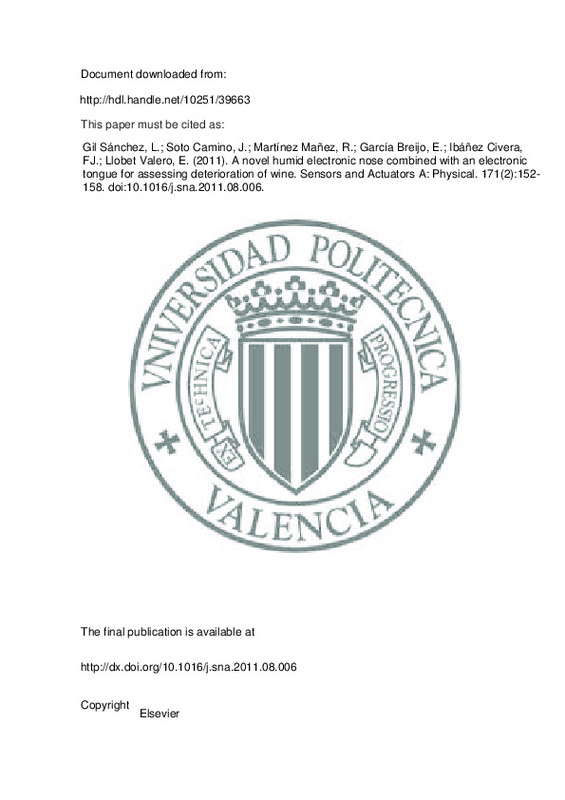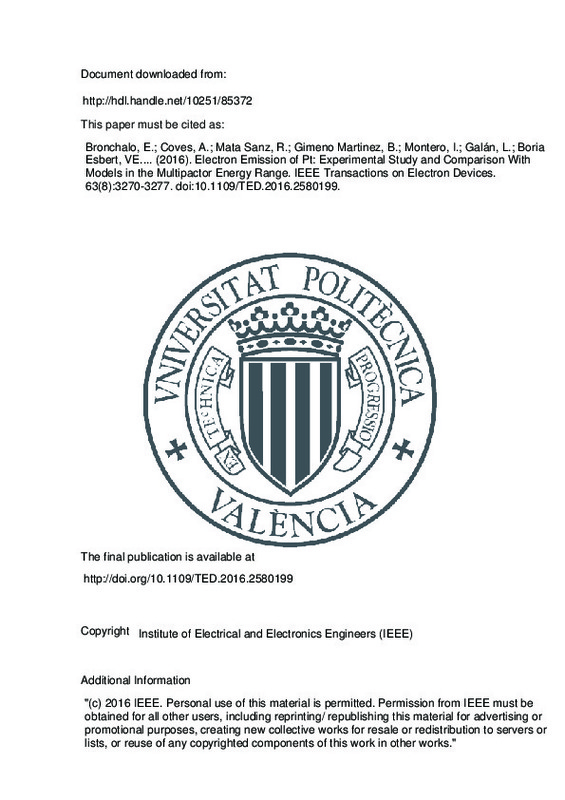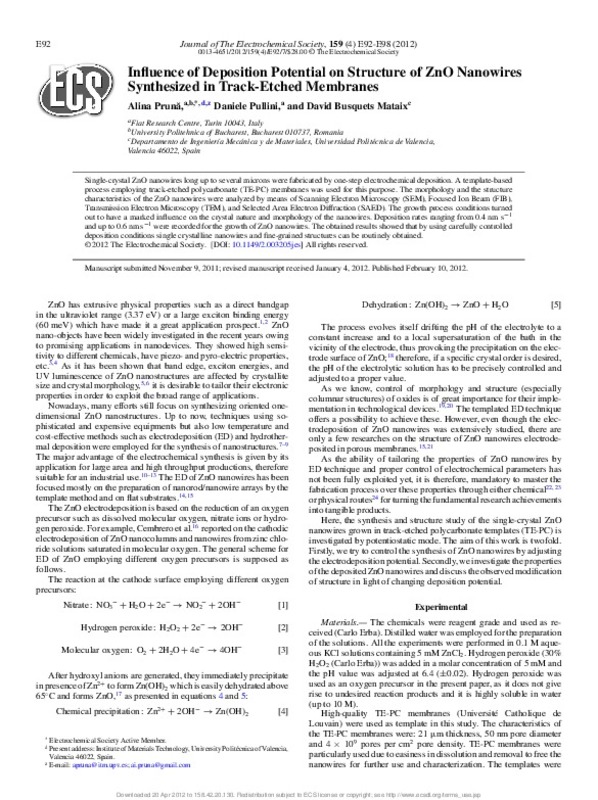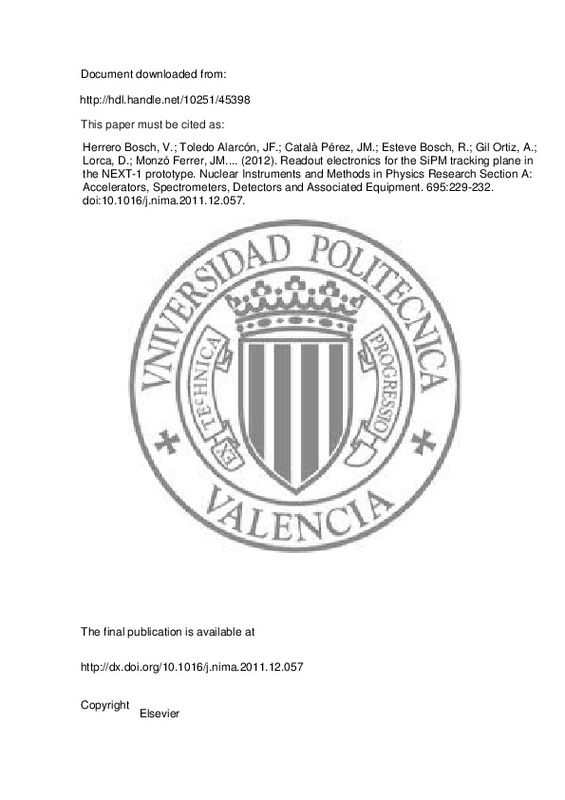Gil Sánchez, L.; Soto Camino, J.; Martínez Mañez, R.; García Breijo, E.; Ibáñez Civera, FJ.; Llobet Valero, E. (2011). A novel humid electronic nose combined with an electronic tongue for assessing deterioration of wine. Sensors and Actuators A: Physical. 171(2):152-158. https://doi.org/10.1016/j.sna.2011.08.006
Por favor, use este identificador para citar o enlazar este ítem: http://hdl.handle.net/10251/39663
|
Título:
|
A novel humid electronic nose combined with an electronic tongue for assessing deterioration of wine
|
|
Autor:
|

 Gil Sánchez, Luís
Gil Sánchez, Luís

 Soto Camino, Juan
Soto Camino, Juan

 Martínez Mañez, Ramón
Martínez Mañez, Ramón

 García Breijo, Eduardo
García Breijo, Eduardo

 Ibáñez Civera, Francisco Javier
Llobet Valero, Eduard
Ibáñez Civera, Francisco Javier
Llobet Valero, Eduard
|
|
Entidad UPV:
|
Universitat Politècnica de València. Instituto de Reconocimiento Molecular y Desarrollo Tecnológico - Institut de Reconeixement Molecular i Desenvolupament Tecnològic
Universitat Politècnica de València. Departamento de Ingeniería Electrónica - Departament d'Enginyeria Electrònica
Universitat Politècnica de València. Departamento de Química - Departament de Química
|
|
Fecha difusión:
|
|
|
Resumen:
|
We report herein the use of a combined system for the analysis of the spoilage of wine when in contact with air. The system consists of a potentiometric electronic tongue and a humid electronic nose. The potentiometric ...[+]
We report herein the use of a combined system for the analysis of the spoilage of wine when in contact with air. The system consists of a potentiometric electronic tongue and a humid electronic nose. The potentiometric electronic tongue was built with thick-film serigraphic techniques using commercially available resistances and conductors for hybrid electronic circuits; i.e. Ag, Au, Cu, Ru, AgCl, and C. The humid electronic nose was designed in order to detect vapours that emanate from the wine and are apprehended by a moist environment. The humid nose was constructed using a piece of thin cloth sewn, damped with distilled water, forming five hollows of the right size to introduce the electrodes. In this particular case four electrodes were used for the humid electronic nose: a glass electrode, aluminium (Al), graphite and platinum (Pt) wires and an Ag-AgCl reference electrode. The humid electronic nose together with the potentiometric electronic tongue were used for the evaluation of the evolution in the course of time of wine samples. Additionally to the analysis performed by the tongue and nose, the spoilage of the wines was followed via a simple determination of the titratable (total) acidity. © 2011 Elsevier B.V.
[-]
|
|
Palabras clave:
|
Electronic nose
,
Electronic tongue
,
Wine quality
,
Ag-AgCl
,
Combined system
,
Distilled water
,
Glass electrodes
,
Moist environment
,
Potentiometric electronic tongue
,
Reference electrodes
,
Wine sample
,
Artificial organs
,
Graphite electrodes
,
Platinum
,
Potentiometers (electric measuring instruments)
,
Silver halides
,
Thick film circuits
,
Wine
,
Electronic tongues
|
|
Derechos de uso:
|
Reserva de todos los derechos
|
|
Fuente:
|
Sensors and Actuators A: Physical. (issn:
0924-4247
)
|
|
DOI:
|
10.1016/j.sna.2011.08.006
|
|
Editorial:
|
Elsevier
|
|
Versión del editor:
|
http://dx.doi.org/10.1016/j.sna.2011.08.006
|
|
Código del Proyecto:
|
info:eu-repo/grantAgreement/MICINN//MAT2009-14564-C04/
info:eu-repo/grantAgreement/GVA//GV%2F2009%2F8650/ES
info:eu-repo/grantAgreement/GVA//PROMETEO%2F2009%2F016/ES/Ayuda prometeo 2009 para el grupo de diseño y desarrollo de sensores/
info:eu-repo/grantAgreement/UPV//PAID-06-09/
|
|
Agradecimientos:
|
We thank the Spanish Government (project MAT2009-14564-C04) and the Generalitat Valenciana (project PROME-TEO/2009/016) for support. Luis Gil-Sanchez also thanks the Universidad Politecnica de Valencia for support (Primeros ...[+]
We thank the Spanish Government (project MAT2009-14564-C04) and the Generalitat Valenciana (project PROME-TEO/2009/016) for support. Luis Gil-Sanchez also thanks the Universidad Politecnica de Valencia for support (Primeros Proyectos de Investigacion - PAID-06-09) and the Generalitat Valenciana (proyectos de I+D para grupos de investigacion emergentes - 2009/8650).
[-]
|
|
Tipo:
|
Artículo
|







![[Cerrado]](/themes/UPV/images/candado.png)





